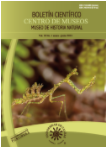Authors
Abstract
Forensic entomology employs the biology and ecology of insects in medico-legal cases. For a precise application in this context, it is necessary to make a correct taxonomic identification in any developmental stage of the specimens related to a case. Incomplete or damaged samples of adults are often obtained from the case scene, making taxonomical identification unlikely. Muscidae is one of the families commonly found in the forensic context. The objective of this study is to describe and to illustrate the morphological characteristics of the adult male genitalia of Biopyrellia bipuncta (Wiedemann, 1830), Musca domestica Linnaeus, 1758 and Synthesiomyia nudiseta (Wulp, 1883), species with forensic importance in Colombia. Male genitalia structures like V sternite, the cercal plate, the surstyli and aedeagus are described and illustrated. Additionally complementary Diagnosis of external morphological characteristics are provided.
References
ANDERSON, G.S. & VANLAERHOVEN, S., 1996.- Initial studies on insect succession on carrion in Southwestern British Columbia. J. Forensic Sci., 41 (4): 617-625.
BARBOSA, R.R., MELLO-PATIU, C.A., MELLO, R.P. & QUEIROZ, M.M.C., 2009.- New records of calyptrate dipterans (Fanniidae, Muscidae and Sarcophagidae) associated with the decomposition of domestic pigs in Brazil. Mem. Inst. Oswaldo Cruz, 104(6): 923-926.
BARRETO, M., BURBANO, M.E. & BARRETO, P., 2002.- Flies (Calliphoridae, Muscidae) and beetles (Silphidae) from human cadavers in Cali, Colombia. Mem. Inst. Oswaldo Cruz, 97 (1): 137-138.
BYRD, J.H. & CASTNER, J.L., 2001.- Forensic entomology: the utility of arthropods in legal investigations. CRC Press, Boca Raton.
CARVALHO, C.J., 1989.- Revisão das espécies e posição sistemática de Palpibracus Rondani (Diptera, Muscidae). Rev. Bras. Zool., 6(2): 325-375.
CARVALHO, C.J. & COURI, M.S., 2002.- Part I. Basal groups: 17-132 (in) CARVALHO, C.J. (ed.) Muscidae (Diptera) of the Neotropical Region: taxonomy. Editora Universidade Federal do Paraná, Curitiba.
CARVALHO, C.J., COURI, M.S, PONT, A.C., PAMPLONA, D. & LOPES, S.M., 2005.- A catalogue of the Muscidae (Diptera) of the Neotropical Region. Zootaxa, 860: 1-253.
CARVALHO, C.J. & MELLO-PATIU, C.A., 2008.- Key to the adults of the most common forensic species of Diptera in South America. Rev. Bras. Entomol., 52 (3): 390-406.
CARVALHO, C.J., MOURA, M.O. & RIBEIRO, P.B., 2002.- Chave para adultos de dípteros (Muscidae, Fanniidae, Anthomyiidae) associados ao ambiente humano no Brasil. Rev. Bras. Entomol., 46: 107-144.
CARVALHO, L.M., THYSSEN, P.J., LINHARES, A.X. & PALHARES, F.A., 2000.- A checklist of arthropods associated with pig carrion and human corpses in southeastern brazil. Mem. Inst. Oswaldo Cruz, 95(1): 135-138.
CATTS, E.P. & GOFF, M.L., 1992.- Forensic entomology in criminal investigations. Annu. Rev. Entomol., 37: 253-272.
EBERHARD, W.G., 1985.- Sexual selection and animal genitalia. Harvard University Press, Cambridge, MA.
GREENBERG, B., 1991.- Flies as forensic indicators. J. Med. Entomology, 28: 565-577.
GRISALES, D., RUIZ, M. & VILLEGAS, S., 2010.- Insects associated with exposed decomposing bodies in the Colombian Andean Coffee Region. Rev. Bras. Entomol., 54: 637-644.
HALL, R.D. & HUNTINGTON, T.E., 2009.- Perceptions and Status of Forensic Entomology: 1-16 (in) BYRD, J.H. & CASTNER, J.L. (eds.) Forensic Entomology: The Utility of Arthropods in Legal Investigations. Ed. CRC, Boca Raton, FL.
HORENSTEIN, M.B., LINHARES, A.X., FERRADAS, B.R. & GARCÍA, D., 2010.- Decomposition and dipteran succession in pig carrion in central Argentina: ecological aspects and their importance in forensic science. Med. Vet. Entomol., 24(1): 16-25.
HOSKEN, D.J. & STOCKLEY, P., 2004.- Sexual selection and genital evolution. Trends. Ecol. Evol. 19: 87-93.
MCALPINE, J.F., 1981.- Morphology and terminology - adults: 9-63 (in) MACALPINE, J.F. (ed) Manual of Nearctic Diptera (Vol 1). Monograph No. 27. Ed. Research Branch Agriculture, Ottawa, Canada
NIHEI, S.S. & CARVALHO, C.J., 2007.- Phylogeny and classification of Muscini (Diptera, Muscidae). Zool. J. Linn. Soc., 149(4): 493-532.
________, 2009.- The Muscini flies of the world (Diptera, Muscidae): Identification key and generic diagnoses. Zootaxa, 1976: 1-24.
OLIVEIRA, T.C. & VASCONCELOS, S.D., 2010.- Insects (Diptera) associated with cadavers at the Institute of Legal Medicine in Pernambuco, Brazil: implications for forensic entomology. Forensic Sci. Int., 198(1-3): 97-102.
RAMOS, R. & WOLFF, M., 2011.- Entomofauna cadavérica asociada a cerdos expuestos al sol y sombra, en el Piedemonte Amazónico Colombiano. Momentos de Ciencia, 8(1): 45-53.
SEGURA, N.A., USAQUÉN, W., SÁNCHEZ, M.C., CHUAIRE, L. & BELLO, F., 2009.- Succession pattern of cadaverous entomofauna in a semi-rural area of Bogotá, Colombia. Forensic Sci. Int., 187(1): 66-72.
SONG, H. & BUCHELI, S.R., 2010.- Comparison of phylogenetic signal between male genitalia and non-genital characters in insect systematics. Cladistics, 26: 23-35.
TUXEN, S.L., 1970.- Taxonomist's glossary of genitalia in insects. Second edn. Scandinavian University Press, Copenhagen.
VASCONCELOS, S.D. & ARAUJO, M.C.S., 2012.- Necrophagous species of Diptera and Coleoptera in northeastern Brazil: state of the art and challenges for the Forensic Entomologist. Revista Brasileira de Entomologia, 56(1): 7-14.
YUSSEFF, S., 2006.- Entomología forense: los insectos en la escena del crimen. Revista Luna Azul, (23): 42-49. Recuperado de http://190.15.17.25/lunazul/downloads/Lunazul23_9.pdf.

 PDF (Español)
PDF (Español)
 FLIP
FLIP






















